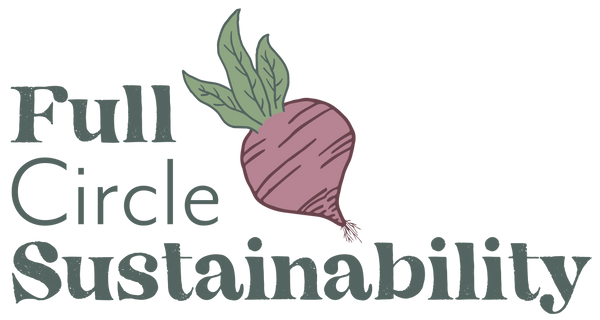
Think Like a Thrift Store: Best Practices for Rehoming Your Stuff
We had a unique opportunity this week to see behind the scenes at one of our favorite local thrift stores. The Giving Tree hosted a tour for the Washburn EcoBods, and we were fortunate to have been included. We got a glimpse into their intake and sorting process, saw the huge area where they store out-of-season items, and learned about some of the logistics and philosophy behind their operations. One thing we love: The Giving Tree partners with the Topeka Rescue Mission to take any clothing and textiles they aren't able to sell. The Rescue Mission uses what they can and sends off the rest for textile recycling. And The Giving Tree is on the lookout for other opportunitites to divert what they can't sell away from the landfill.
It's worth noting that, despite everyone's best efforts, many donated items do end up in the trash. That's important to keep in mind when deciding what to do with items you no longer want. Giving usable items to a thrift store is absolutely preferable to throwing them away. But just as "wishcycling" is detrimental to the recycling system overall, donating items that are broken, moldy, or smelly to a thrift store is counterproductive. Sorting out these unsellable items takes employee time and fills up dumpster space—both of which cost money. So our first two tips for thinking more like a thrift store:
It's worth noting that, despite everyone's best efforts, many donated items do end up in the trash. That's important to keep in mind when deciding what to do with items you no longer want. Giving usable items to a thrift store is absolutely preferable to throwing them away. But just as "wishcycling" is detrimental to the recycling system overall, donating items that are broken, moldy, or smelly to a thrift store is counterproductive. Sorting out these unsellable items takes employee time and fills up dumpster space—both of which cost money. So our first two tips for thinking more like a thrift store:
- Before donating, check the organization's website for a list of accepted items. If you still have questions, ask the staff. Many thrift stores do not sell used strollers, car seats, bike helmets, or mattresses, for example. If they can't take your items, they may be able to suggest another place that can.
- Be honest about whether your items are in good enough shape to sell. If not, trying to rehome them (by giving them away on Facebook Marketplace or Buy Nothing, setting them at the curb, offering them to folks who can fix them) or simply putting them in the trash or recycling yourself may be the most honorable option. This is especially the case for large items such as furniture, which are cumbersome for staff to deal with and take up lots of space in the dumpster. It also applies to anything that will be a burden for the shop to dispose of, such as hazardous materials or CRT televisions they'll have to pay to recycle.
That being said, if your items are in good condition, give the thrift store a try! We were surprised to find out how well certain items sell (like knick-knacks and home decor). One person's kitsch is another person's collectible!
A few other tips for "thinking more like a thrift store" and finding the best home for your unwanted items:
- When you can, donate items that are in season (or will soon be in season) so the store doesn't need to hold onto them for months. Storage space costs money! Keep in mind that holiday items start selling a few months in advance, so shoot for donating Christmas items in September rather than immediately before or after the holiday.
- When you donate, "sell" the thrift store first. A bunch of wrinkled, musty clothing stuffed in a bag or a board game in a broken box with pieces all over the place not only take staff time to process, they don't give the impression of being easy to sell. For the best chance that your items will be resold, wash and fold clothing, make sure items with multiple parts are packaged together, and include owner's manuals. Think about how you'd like to see the item if you were buying it yourself, and give it to the thrift store in that condition.
- Used items sell best when people know where to look for them—which is typically with items of the same type. For example, a used sporting goods store is the ideal place to sell sporting goods. A used electronics shop is the best place for used electronics. Scraps KC is the perfect place in our area to take old arts, crafts, and office supplies. It may not always be practical or possible to group your used items with similar ones, but considering this factor when deciding where to donate can increase the liklihood that an item will actually find a new home.
- When your item appeals to a very specific buyer, try finding that person on the internet. What is the chance that someone browsing the shelves at The Giving Tree will find and want your signed copy of accordion player Frankie Yankovic's autobriography? Zero chance! Listing it someplace like eBay lets you cast a wide net. If someone out there is looking for it, the internet can be the best way of finding them. Thrift stores do sometimes list items on eBay, but since this takes staff time, they're unlikely to do it for items that won't bring a decent profit.
- Try using social networks (both in person and online). An even better way than eBay to rehome specialized items can be reaching out to a group of people with a related hobby or interest. A post in an online forum, notice in a newsletter, or sign on a bulletin board can help you find people who might want the thing you're trying to get rid of. Similarly, you could contact a university music library about donating sheet music or ask your school-librarian friend about rehoming children's books.
- Finally, reduce your need to rehome stuff in the first place. It can be easy to justify buying new things because we can simply give the old ones to a thrift store. But in most cases, you don't know what will ultimately become of the items you donate—and you might be disappointed to find out. Thrift stores are wonderful places for connecting used items and people who will appreciate them. But we can't see them as a full solution to our society's problems of overproduction, overconsumption, and dumping into a landfill the stuff that no one wants.
Thanks to The Giving Tree for showing us around their shop and for prompting us to think more like a thrift store when we sell, give, and donate!
-Justine




